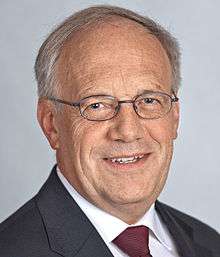President of the Swiss Confederation
| President of the Swiss Confederation
(German) Bundespräsident(in) der Eidgenossenschaft (French) Président(e) de la Confédération (Italian) Presidente della Confederazione (Romansh) President(a) da la Confederaziun | |
|---|---|
| Residence | Federal Palace |
| Term length | 1 year, not eligible for re-election immediately |
| Inaugural holder | Jonas Furrer |
| Formation | 21 November 1848 |
| Website | www.admin.ch |
.svg.png) |
| This article is part of a series on the politics and government of Switzerland |
|
The President of the Confederation (German: Bundespräsident(in) der Eidgenossenschaft, French: Président(e) de la Confédération, Italian: Presidente della Confederazione, Romansh: President(a) da la Confederaziun) is the presiding member of the seven-member Swiss Federal Council, Switzerland's executive. Elected by the Federal Assembly for one year, the President of the Confederation chairs the meetings of the Federal Council and undertakes special representational duties. Primus inter pares, the President has no powers over and above the other six Councillors and continues to head her/his department. Traditionally the duty rotates among the members in order of seniority and the previous year's Vice President becomes President.
As first among equals, the Federal Council member serving as President of the Confederation is not considered the Swiss head of state. Rather, the entire Federal Council is considered a collective head of state.
The constitutional provisions relating to the organisation of the Federal Government and Federal Administration are set out in section 1 of Chapter 3 of the Swiss Federal Constitution[1] at articles 174 to 179. Article 176 specifically relates to the Presidency.
Competencies
The Swiss President is not – as are, for example, the Presidents in Austria or Germany – the head of state of the country: under the Swiss Federal Constitution, the Federal Council doubles as a collective head of state and head of government. If a tied vote occurs in the council (which does not happen too often, the number of Federal Councillors being an odd number), the President, being its Chair, casts the deciding vote.
In addition to the control of his or her own Department, the President carries out some of the representative duties that are normally carried out by a single head of state in other democracies. At first this was only the case inside Switzerland, where the Presidente President also often travels abroad; previously, the head of the Federal Department of Foreign Affairs handled most of those visits.
However, because the Swiss have no single head of state, the country also carries out no state visits. When traveling abroad, the President does so only in their capacity as head of their department.
Visiting heads of state are received by the seven members of the Federal Council together, rather than by the President of the Confederation. Treaties are signed on behalf of the full Council, with all Federal Council members signing letters of credence and other documents of the kind.
Election
The President is elected by the Federal Assembly from the Federal Council for a term of one year.
In the 19th century, the election of the Federal President was an award for especially esteemed Federal Council members. However, a few influential members of the government were regularly passed over. One such example was Wilhelm Matthias Naeff, a member of the Federal Council for 27 years, but was Federal President only once in 1853.
Since the twentieth century, the election has usually not been disputed. There is an unwritten rule that the member of the Federal Council who has not been Federal President the longest becomes President. Therefore, every Federal Council member gets a turn at least once every seven years. The only question in the elections that provides some tension is the question of how many votes the person who is to be elected President receives. This is seen as a popularity test. In the 1970s and 1980s, 200 votes (of 246 possible) was seen as an excellent result, but in the current era of growing party-political conflicts, 180 votes are a respectable outcome.
Until 1920, it was customary for the serving Federal President to also lead the Department of Foreign Affairs. Therefore, every year there was a moving around of posts, as the retiring President returned to his former department and the new president took up the Foreign Affairs portfolio. Likewise, it was traditional for the Federal President not to leave Switzerland during his year in office.
See also
Notes and references
External links
- Official website
- President of the Confederation in German, French and Italian in the online Historical Dictionary of Switzerland.

